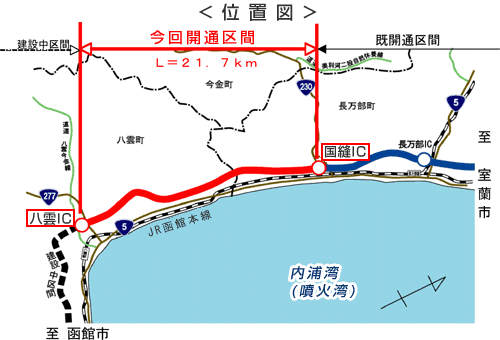Outline of the opening section of the Do-O Expressway Yakumo IC-Kunnui IC (opening effect and features of construction)
- Corporate Top
- Press Room
- Press Release Headquarters
- Outline of the opening section of the Do-O Expressway Yakumo IC-Kunnui IC (opening effect and features of construction)
October 13, 2006
East Nippon Expressway Co., Ltd.
1 Outline of open section
Do-O Expressway is part of the Hokkaido Transverse Expressway that connects Donan, Doo, and Dohoku, and is a highway expressway that has been open for about 375 km between Kunishi IC and Shibetsu Kenbuchi IC.
The section to be opened this time will proceed southwest of the already opened Kunashiri IC (toward Hakodate), and along the coastal terrace facing Uchiura Bay (Eruption Bay), alongside National Route 5 and JR Hakodate Main Line, Hokkaido It is a 21.7km long section that connects to general national highway No. 277 at Yakumo IC of Yakumo Town, Nikai-gun.
With this opening, the Do-O Expressway will be extended further toward South.
- Interchange (1 place)
Yakumo IC Tateiwa, Yakumo Town, Nikai-gun, Hokkaido (Connected with general national road 277) - Number of lanes and design speed
1. 2 lanes (provisional)
2. Design speed 100km/h - Construction overview
1. Project cost about 32.8 billion yen
2. Structure extension
Earthwork extension 21.0km (97%)
Bridge length 0.7km (3%)

2 Effect of opening
(1) Improvement of network achievement rateWith this opening, the high-speed transportation network achievement rate from the central Hokkaido area to the southern Hokkaido area will increase by 8%, forming about 80% of the total.
This is expected to greatly contribute to the development of socio-economic activities such as promoting exchanges between regions and activating the tourism industry, as well as economic activities such as logistics and transportation.

(2) Reinforcement of network function at the time of disaster
Logistics and emergency transportation will be strengthened by strengthening cooperation with general national highway No. 5 and the surrounding highway network, and by connecting with national highway No. 277, strengthening wide-area network functions such as alternative roads in the event of a disaster. The road is secured and can play an important role as a lifeline in the areas along the way.
(3) Ensuring safe living
By using the section that will be opened this time, the transportation time from the towns and villages along the line to the second emergency medical facility (designated regional disaster/Yakumo General Hospital) can be shortened by up to about 6 minutes compared to the past, and you can live with peace of mind. It is expected that it will contribute to securing a living and building an emergency medical system.
3 Features of construction
- The surface of the running pavement (asphalt surface work) is paved so that it can be more durable and maintain the condition of the road surface for a long period of time.
- For the protection fence (guard rail) installed on the road, NEXCO EAST was the first in Japan to directly procure inexpensive materials from overseas, and to reduce the construction cost compared to the conventional procurement method.
